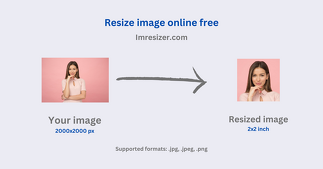How to scale pixel size of image on a web site? Need to print to a given photo px? The size of pixels is important than you could imagine. The right image px size will make your photos look sharp in any place where they are used. Nowadays, it is very easy to translate the measurements in pixels and scale pictures without compromising quality with modern tools. This tutorial tells you all about the correct way of changing pixel sizes.
What Are Pixel Dimensions?
The number of pixels across the width and height of your image is called pixel dimensions. A 1000x1000 image size of the pixels have a total of a million pixels. The larger the pixels, the higher the quality, although the size of the file is also increased. Photo px requirements vary by platform - social media as well as websites and print shops all have their own requirements.
How to Change Pixel Size of Image Properly
The two most common techniques of changing pixel size include resizing and resampling. Resampling can add or remove pixels to your picture, but resizing does not change the size of an image, it only moves it physically. In most cases, you need to resample your image to fit some dimensions. Modern tools add pixels with intelligent algorithms that do not make your image look blocky or hazy.
When Should You Change Pixel Dimensions?
Several situations require pixel adjustment:
Web Optimization: Making websites smaller to load faster Social
Media: Platform dimension requirement Print
Preparation: It should be prepared so that the quality printing Email will be possible.
Attachments: Make files smaller in order to share them Storage
Management: Forming smaller versions as a backup.
Key Features of a Quality PX Converter
The best tools for how to change pixel size of image offer:
Accurate Dimension Manage: This is whereby the height and width are entered with correct values.
Aspect Ratio Lock: Resize with proportions.
Bulk Processing: Process a large number of images at the same time.
Format Preservation: Converting the images without changing the quality.
Instant Preview: View changes before completion.
The Right Way to Convert PX Measurements
Follow these steps for best results:
Develop Requirements: See what measurements you require in your case.
Keep Aspect Ratio: Keep proportions fixed without being deliberately distorted.
Resampling Technique: Choose the right algorithm according to the kind of image you have.
Quality of Review: The results should be examined at 100% magnification and only then completed.
Save In a Proper Way: You need to choose the right type of file you need.
Common Pixel Size Mistakes to Avoid
Many people make these errors when changing image px:
Overscaling -Excessive Pixels In one design, too many pixels lead to blurry images.
Aspect Ratio Ignored: It causes image distortion and exaggeration.
Over-Compressing: Compromise soldiers.
Bad Format: graphics in JPEG or photos in PNG.
No Backup: Editing originals, as opposed to copywriting.

How to Maintain Quality When Changing PX
Quality preservation requires understanding several factors:
Quality of the source: Use the best quality original possible.
Resampling Option: Select bicubic smoother to reduce, sharper to enlarge Compression.
Balance Select the quality/file size balance that best fits your requirements.
Sharpening: use slight sharpening following resizing to keep the image clear.
Format Choice: Lossless when quality is important.
Pro Tips for Perfect Pixel Conversion
Follow these professional techniques:
Original: Use the best version in the first place.
Save Presets: Save templates in commonly used dimensions.
Transform Batch: Process several images simultaneously to be consistent.
Check Requirements: Verify the platform specs prior to conversion.
Keep Originals: It is always a good practice to hold on to original high resolution files.
FAQ: Your Pixel Conversion Questions Answered
Q: Does an image quality change with pixel size?
A: Smoothing pixel size usually preserves quality, whereas going too large or doing it badly can lead to loss of quality.
Q Which is the difference between pixels and resolution?
A: The number of pixels in a picture is the literal number of points, whereas the distribution of those points is called the resolution (typically expressed in PPI - pixels per inch).
Q: Is it possible to turn pixels into inches?
A: Yes, but you must know what the resolution is to be. An example is 300 pixels at 300 PPI will be 1 inch and 300 pixels at 72 PPI will be approximately 4 inches.
Q: Which is the best format of resized images?
A: JPEG photographs, PNG transparency graphics, and WebP Web-based use with the quality and compression advantage.
Q: To what extent do I have to enlarge an image before its quality is compromised?
A: Most images may be enlarged by 10-15 percent without significant loss in quality, however, based upon the quality of the original image, and the enlargement algorithm applied.